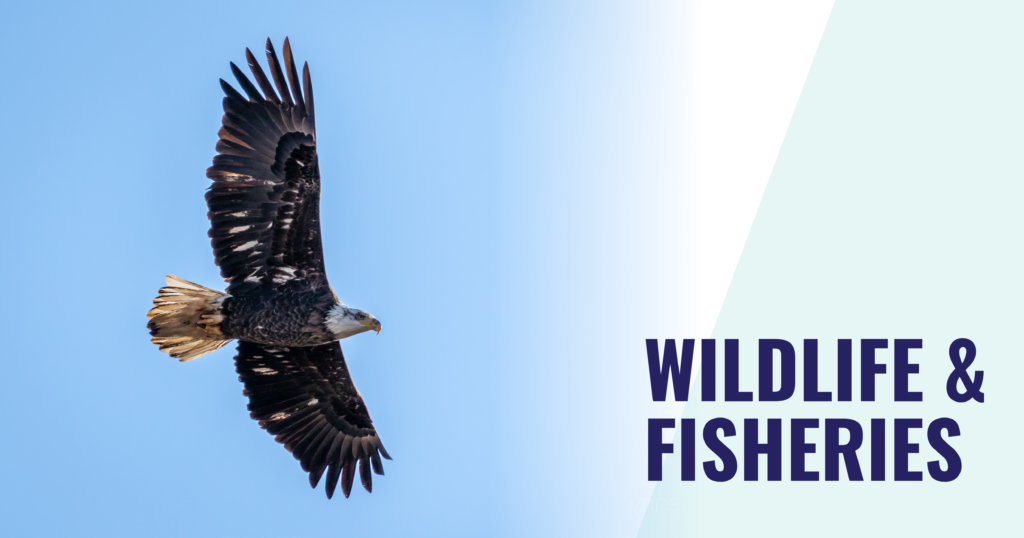
Welcome to week one of Our Common Agenda Education Series, featuring the Wildlife & Fisheries chapter of Our Common Agenda. Read below for the latest on Virginia’s wildlife corridors, mussel populations, and oyster populations. While you’re at it, make sure to check out our other weeks of education here.
Wildlife Corridors
Wildlife corridors, or connections between patches of important habitat, protect public health, reduce wildlife-vehicle collisions, allow wildlife to move to more suitable habitats, and make our state more resilient in the face of a changing climate. Protecting wildlife corridors helps to keep our ecosystems intact.
Virginia’s General Assembly, with leadership from Senator Dave Marsden and Delegates Bulova, Plum, and Keam, passed legislation to authorize the Wildlife Corridor Action Plan that will improve the identification of wildlife corridors and to develop a coordinated strategy to protect these connections. However, there remains much work to do. Increased funding to support wildlife corridor creation, an analysis of a road-stream crossings prior to road-stream replacement and repair projects, flexibility to implement easy and cost-effective solutions, and an increased understanding of wildlife movement and wildlife-vehicle collisions will better protect both wildlife and drivers from roadway collisions.
Our policy recommendations
- Direct VDOT to systematically collect wildlife carcass removal data across Virginia and make that data publicly available.
- Direct VDOT to determine the Aquatic Organism Passage (AOP) status of a road-stream crossing prior to replacement/repair projects and update design standards to ensure habitat connectivity and resiliency for all road-stream crossing projects.
- Direct VDOT to include exclusionary fencing in annual allocations for safety upgrades.
- Provide incentives for landowners to protect and restore wildlife corridors.
- Provide resources to the Department of Wildlife Resources and partners to launch a statewide effort to assess barriers to aquatic connectivity and make the data publicly accessible.
Want to see wildlife corridors in action? See Environment America’s report, “Reconnecting Nature,” for an interactive web tour of seven different types of wildlife corridor projects across the U.S.
Thank you to our Partners for their continued support of strong wildlife corridor policy:Wild Virginia, Wildlands Network, The Nature Conservancy, James River Association, Friends of the Rappahannock, and Piedmont Environmental Council.
Mussels
Virginia’s mussels are at a crossroads – just as scientists begin to discover the abundant benefits that mussels provide to our Chesapeake Bay, rivers, and creeks, our mussel populations are plummeting.
A single mussel can filter up to 15 gallons of water per day, which in turn can prevent pollutants such as nitrogen from reaching downstream waters. Just as we need to increase our efforts to clean up our watershed, we find that a free and natural source, mussels, represent the most endangered class of organisms with 70% of species vulnerable to extinction. Virginia has 80 species, many have incurred significant population losses.
The bottom line is that while mussels have evolved to withstand a variety of extreme conditions, our waterways today are degraded beyond these levels—and that is one of the reasons these populations are so degraded.
Our policy recommendations
- Dedicate funding ($400,000 over the biennium) to develop a freshwater mussel restoration plan for the Commonwealth, including two state employees dedicated to the protection and restoration of freshwater mussels.
- Provide funding ($2M) to increase mussel restoration projects at hatcheries across the Commonwealth.
- Make initial investment ($5M) in needed renovations and expansions at the Aquatic Wildlife Conservation Center at the Buller Fish Hatchery in Southwest Virginia to meet mussel production needs and synergize with the new Clinch River State Park.
Thank you to our Partners for their advocacy for our “unsung heroes:” Dr. Joe Wood and the Chesapeake Bay Foundation, James River Association, and The Nature Conservancy in Virginia.
Oysters
With their three-dimensional structure and ability of each adult oyster to filter up to 50 gallons of water per day, they provide numerous ecological benefits including habitat for fish and other shellfish, pollution reductions, and increased water clarity in both brackish and coastal Virginia waters. In addition, oysters are becoming more and more important to coastal resiliency efforts as they help effectively protect both intertidal and upland habitats.
Unfortunately, overfishing, disease, and pollution have all taken their toll on this keystone species. There was a time when the oyster population in the Bay was so vast, the entire 19 trillion gallons of water could be filtered in less than a week. Today, our current population takes a whole year to filter the Bay.
Restoring Virginia’s oyster population will require broad partnerships, wise management of the existing oyster resource, and adequate resources.
Our Policy Recommendations
- Direct the Virginia Marine Resources Commission (VRMC) and the Virginia Institute of Marine Science to comprehensively map and sample all oyster growing areas in the waters of the Commonwealth.
- Appropriate approximately $112,000 to hire a stock assessment scientist in order to supplement the VMRC’s management of this important resource and other species that are biologically connected to oyster habitat in Virginia’s waters.
Thank you to our Partners at Chesapeake Bay Foundation, Friends of the Rappahannock, and The Nature Conservancy in Virginia for their continued work to protect and restore Virginia’s oyster populations!
